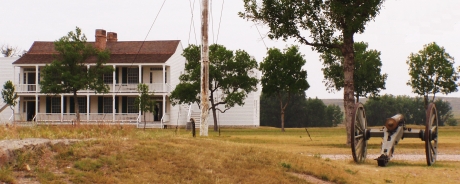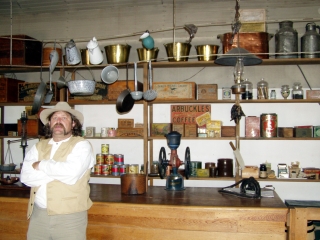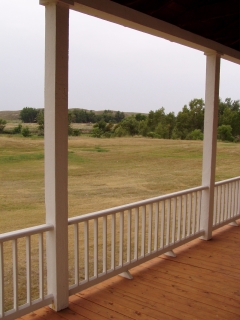NPS Website; Local Website; Bookstore Website
 WHAT IS IT?
WHAT IS IT?Perhaps the most fabled of all the American West frontier forts. Fort Laramie played a vital part in every stage of the West’s development. The Site exists of a mixture of the Fort’s original buildings. The NPS have beautifully restored and refurbished some structures while it has let other lie in ruin with only their stone shells in view.
BEAUTY (6/10)
History comes alive at Fort Laramie NHS. The mix of reconstructed structure and buildings standing in ruin is an inspired touch. Even though the history is only 150-odd years old, we got a feeling similar to the ruins of ancient Rome and Greece. Fort Laramie is a time that has past, but these are their stones and frames. The sightlines in all directions are bare; no other houses, no roads and no McDonald’s. You see exactly what they saw.
HISTORICAL INTEREST (9/10)
Not only was Fort Laramie the arguable center of the American West, but through its many incarnations, it represented an entire century of commerce, development and war. The Fort does a tremendous job explaining both the large historical role of Fort Laramie as well as the day to day life of the soldiers and the homesteaders that lived on the land after the Fort’s dismantling.
When first built, Fort Laramie served as an important fur trading post, similar to Bent’s Old Fort NHS in Colorado and Fort Union Trading Post NHS in North Dakota. As the mass migration westward began, Fort Laramie transformed into a protective military post. It became an important stop along the California Trail, the Oregon Trail, the Mormon Trail, the Pony Express and the short-lived and catalytic Bozeman Trail.
The presence of the gold prospectors moving along the Bozeman Trail started a war. In 1861, the U.S. Government had promised the Lakota and the Cheyenne the northern Wyoming land in a treaty signed at Fort Laramie. Gold discovery changed everything. Red Cloud fought back, stopping the Bozeman traffic and ensuring the Black Hills land for his descendants in another landmark treaty signed in 1868 at Fort Laramie.
The 1868 Fort Laramie Treaty was broken soon after when gold was found in the Black Hills. Soldiers outposted at the Fort were ordered to defend the treaty and, ironically, protect the Indians that they had just fought. Of course, the soldiers did not succeed. Nonetheless, the treaty still stands, because the Indians stipulated that the treaty’s annulment must contain the signature of ¾ of the entire male Lakota population. Just recently, the Supreme Court decided on a dollar amount to repay the tribe for the broken Treaty. The Lakota refused the money, insisting on the land. The repayment money today stands at nearly $400 million dollars. The Fort Laramie Treaty of 1868 lives on.
 CROWDS (7/10)
CROWDS (7/10)For a remote site, Fort Laramie NHS had many guests. We heard different languages for the first time since April, when we were at Ellis Island. Dutch, German, French, Spanish and Queen’s English. It was encouraging to see people interested in such a significant place.
EASE OF USE/ACCESS (2/5)
Fort Laramie NHS is located three miles south of U.S. Route 26 near the town Fort Laramie. Fort Laramie, Wyo. is 28 miles east of Interstate 25, Exit 92.
We expected to see few people at such a remotely located Site. We were wrong. A Volunteer explained that Fort Laramie NHS lies along a tourist circuit frequented by tourists, both domestic and foreign. Visitors fly into Denver, rent a car, go to Rocky Mountain NP, travel north to Fort Laramie, continue North to the Black Hills, turn westward toward Yellowstone NP and the Grand Tetons and then they find their way back to Denver.
We should not have been too surprised. That is, more or less, the route we are on. Sounds like a great trip and a superb way to see the United States. All those stops, Fort Laramie included, are essential destinations.
CONCESSIONS/BOOKSTORE (5/5)
A stunningly thorough bookstore. Books are sorted by seven different categories that are all relevant to the history of Fort Laramie. Each of these categories has an astonishing collection. There are 115+ titles based on the military history of the West, 100+ books on women and the West, 100+ children’s books, and 115+ books on Native American history. None of the titles are repeated between sections.
Many bookstores we have visited spread themselves thin by focusing on too many topics. Not Fort Laramie NHS. We received a mimeographed 15-page handout that just lists the books for sale. Fifteen pages! You can peruse the list at http://www.fortlaramie.com/. We spent at least a half hour browsing.
The bookstore also offers a large selection of music CD’s, posters, maps, books on tape, postcards and knick-knacks. You can also buy stuffed animals, cavalry hats, patches, hard tack, soaps and bonnets.
COSTS (3/5)
Admission is $3 per person. Children, defined here as 16 and under, are free. There is no entry fee if you have the National Parks Pass.
RANGER/GUIDE TO TOURIST RATIO (3/5)
Throughout Fort Laramie’s buildings we encountered one period-dressed Ranger ‘working’ the Trading Post room, one volunteer manning the Soldier’s Bar and another volunteer available at the Calvary’s barracks. They both were spectacular. We spent at least 45 minutes talking to the Ranger. We wished that there had been more Rangers, especially since the mid-week crowds were large. Admittedly, we had every question answered and were lavished with lots of attention.
We did learn that in the late seventies, Fort Laramie NHS enjoyed a summer staff of 12 period-dressed Rangers manning each of the buildings, explaining life at the Fort. That must have been something, a time when preserving our history and teaching the past was deemed important.
 TOURS/CLASSES (9/10)
TOURS/CLASSES (9/10)The strength of our Fort Laramie NHS visit rests entirely on the skill of the Ranger we met. He thoroughly explained all aspects of the Fort and its history. He was especially helpful in the two places we talked, the Trading Post and the period garden, pointing out the intriguing minutiae we might have normally overlooked. When we browsed other rooms sans Ranger, we felt saddened and lost, knowing that little treasures and illuminating anecdotes abounded but that we had no means hear those stories.
FUN (8/10)
After we pried ourselves away from the amazing bookstore, we went for a soda at the Enlisted Men’s Bar. We sipped sarsaparilla and ginger beer, admired the original pool table with carved legs, one of many original pieces from the fort, and chatted with the period-dressed volunteer. We took his suggested route around the fort and wandered for at least three hours. We were never bored. The Ranger we found was a treasure of information. He really knew his stuff. We could have spent hours talking with this friendly portly gentleman had we not felt guilty about keeping him to ourselves. We left Fort Laramie feeling fully informed and armed with directions to Nebraska’s best hamburger for the next day’s lunch. Thank you, Mr. Ranger!
WOULD WE RECOMMEND? (8/10)
Of the western Fort’s we have visited, Fort Laramie is the most significant. It also encompasses the most history. If you are traveling throughout the west, Fort Laramie NHS should definitely be on your list of must-sees.
TOTAL 60/80
www.usa-c2c.com
© 2004-06